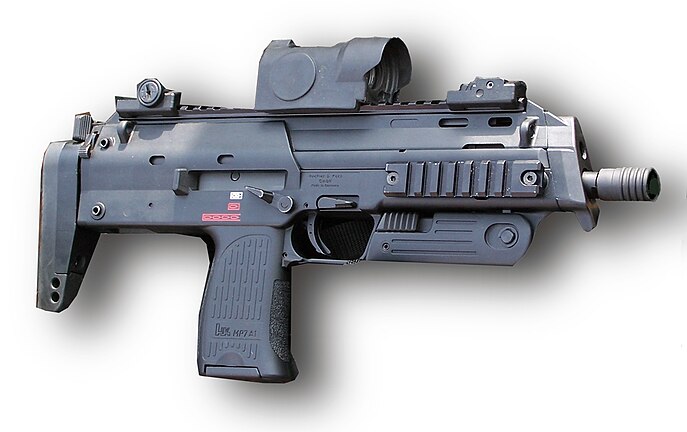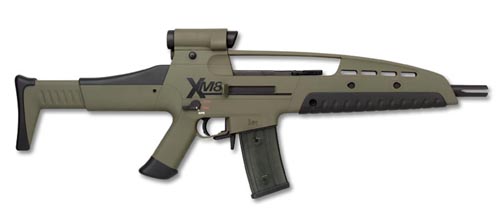New Weapon
XM307 Advanced Crew Served Weapon
he XM307 Advanced Crew Served Weapon (ACSW) was a developmental 25 mm belt-fed Grenade Machine Gun with smart shell capability. It is the result of the OCSW orObjective Crew Served Weapon project. It is lightweight and designed to be two-man portable, as well as vehicle mounted. The XM307 can kill or suppress human beings out to 2,000 meters (2,187 yd), and destroy lightly armored vehicles, watercraft, and helicopters at 1,000 meters (1,094 yd). The project was canceled in 2007.[1]

Heckler & Koch MP7
he MP7 is a German submachine gun manufactured by Heckler & Koch (H&K) and chambered for the 4.6x30mm cartridge. It was designed in conjunction with the new cartridge to meet NATO requirements published in 1989 calling for a personal defense weapon (PDW) class firearm with a greater ability to defeat body armor than current weapons, which are limited due to the use of conventional pistol cartridges. The MP7 went into production in 2001. It is a direct rival to the FN P90, also developed in response to NATO's requirement. The weapon has been revised since its introduction and the current production version is the MP7A1.
The proliferation of high-quality body armor has begun to make guns that fire pistol ammunition (such as HK's earlier MP5 submachine gun or USP pistol) ineffective. In response to this trend, HK designed the MP7 (along with the now cancelled UCP pistol, which uses the same ammunition) to penetrate body armor, but small enough to be used in place of either apistol or a submachine gun.[1]

Milkor MGL
The MGL (Multiple Grenade Launcher) is a lightweight 40 mm semi-automatic, 6-shot grenade launcher developed and manufactured in South Africa by Milkor (Pty) Ltd. The MGL was demonstrated as a concept to the South African Defence Force (SADF) in 1981. The operating principle was immediately accepted and subjected to a stringent qualification program. The MGL was then officially accepted into service with the SADF as the Y2. After its introduction in 1983, the MGL was gradually adopted by the armed forces and law enforcement organizations of over 30 countries; it has since proven its effectiveness in harsh environments ranging from rain forests to deserts. Total production since 1983 has been more than 50,000 units.
The MGL is a multiple-shot weapon, intended to significantly increase a small squad's firepower when compared to traditional single-shot grenade launchers like the M203. The MGL is designed to be simple, rugged, and reliable. It uses the well-proven revolver principle to achieve a high rate of accurate fire which can be rapidly brought to bear on a target. A variety of rounds such as HE, HEAT, anti-riot baton, irritant, and pyrotechnic can be loaded and fired as fast as the trigger can be pulled; the cylinder can be loaded or unloaded rapidly to maintain a high rate of fire. Although intended primarily for offensive and defensive use with high-explosive rounds, with appropriate ammunition the launcher is suitable for anti-riot and other security operations. A newly patented modification allows the MGL to fire less lethal (very low pressure) rounds.

LWRC M6
The M6 is a series of carbines designed and manufactured by LWRC. It is based on the M4 carbine, with which it shares 80% of its parts.[1] The 'M' model name is not a US military designation. Like the HK416, it features a proprietary short-stroke self-regulating gas piston system and bolt carrier/carrier key design, which prevents trapped gases from contacting the bolt carrier or receiver of the weapon, which reduces the heating and carbon fouling of the internals; simplifies field maintenance, and improves reliability.[1]
Standard length barrel is 16.1 in, with a 1/7 in twist (6 lands, right twist) barrel with a ferritic nitrocarburized surface conversion which covers the barrel, inside and out, as well as the piston components.
The Discovery Channel show Future Weapons featured the M6A2 and the M6A4.

Barrett M468
The 6.8 SPC chambered Barrett M468 rifle employed the same direct gas-impingement system as the M4. The result was a system that jetted hot gases directly into the rifle’s receiver, leading to potential stoppages if regular maintenance and cleaning protocols were overlooked. Barrett was still selling its limited stock of the M416 but only as an upper receiver kit and not as a complete rifle up until 2010.[1]

XM8 rifle
The XM8 was a developmental U.S. Military designation and project name for a lightweight assault rifle system that was under development by the United States Army from the late 1990s to early 2000s. The Army worked with the German small arms manufacturer Heckler & Koch (H&K) to develop the system to its requirements in the aftermath of the Objective Individual Combat Weapon (OICW) contract, for which H&K had been a subcontractor to ATK. Although there were high hopes that the XM8 would become the Army's new standard infantry rifle, the project was put on hold in April 2005, and was formally canceled on October 31, 2005.
General Dynamics was involved in latter stages and H&K had plans to produce the rifle at a plant in Georgia. H&K was British-owned at the start of the project, but was later bought back by a group of German investors. Engineering work was done at facilities in the United States and Germany.

50 Beowulf
The .50 Beowulf [12.7 x 42 mm Rb] is a rifle cartridge developed by Alexander Arms for use in a modified AR-15 rifle. The cartridge utilizes a rebated rim, sized to match the rim of the 7.62x39mm and 6.5 mm Grendel rounds. It is very similar in dimensions to the .500 S&W Magnum revolver cartridge.
According to the manufacturer, it was descended from the .50 Action Express, a cartridge originally developed for the Magnum Research Desert Eagle pistol, with significant modification to improve functionality and safety in the AR-15 platform.[1]
The round is intended to improve stopping power greatly at short-to-medium range as compared to the standard 5.56mm. One of its advertised uses is at vehicle checkpoints, since the heavy bullet's flight path is not easily deflected by auto glass or standard vehicle body panels.

Adapted From:





